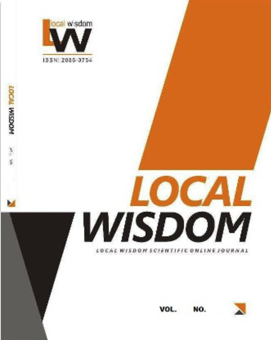Study of Theory Based on Security at Silimo Settlement in The Baliem Valley of Papua
DOI:
https://doi.org/10.26905/lw.v14i2.7594Keywords:
Concept of space, concept of security, Silimo settlement, and the Hubula tribeAbstract
In the Baliem Valley, Papua, the tradition of tribal wars in the culture of the Hubula tribe in the past is related to the concept of site selection, spatial planning, and building form in the Silimo settlement. The problem in this study is how the selection of location, spatial planning, building form, and territoriality become the concept of security in a traditional settlement. The purpose of the study was to determine the security concept in traditional Silimo settlement that consists of site selection, spatial planning, building form, and territoriality based on security theory in settlements. In answering the problem of this research, the researchers use qualitative research methods. The researchers also use a phenomenological approach to explain or reveal the meaning of concepts or phenomena of experience based on the awareness that occurs in several individuals related to security in the Silimo settlement. The theories used in this research are the security theory in crime prevention and the theory of defensible space. The result of this research is that security theory can explain that the selection of location, spatial planning, and building form in the Silimo settlement of the Hubula Tribe in the Baliem Jayawijaya Valley was built based on the traditional conception of security. The concept of security in the Silimo settlement can be realized by: 1) The concept of territory as a defense space and territory as a territory of power; 2) The concept of space as a personal space and a public space: 3) The concept of Kinship, confederation, norms, customary rituals, which become the Patterns and Concepts of Space and Building Forms and Constructions are forms of Social Relations, Natural Relations and Ancestral Relations, to actualize a security system in Silimo settlement.Downloads
References
Amalia, A. A., & Amal, C. A. (2018). Teritorialitas Ruang Pada Permukiman Kampung Melayu Kota Makassar. Jurnal Linears, 1(1), 28–34.
Burhanuddin, Setioko, B., & Suprapto, A. (2015). Teritorialitas Ruang Pada Jalur Penggal Jalan Kyai H. Agus Salim Kota Semarang “Hubungan Perilaku Pengguna Teritori dengan Seting Jalur Jalan.†54–65.
Cozens, P. M., Saville, G., & Hillier, D. (2005). Crime prevention through environmental design (CPTED): a review and modern bibliography. Property Management, 23(5), 328–356. https://doi.org/10.1108/02637470510631483
Gantini, C. (2014). Arsitektur ‘Bale Banjar’Adat Sebagai Representasi Arsitektur Pertahanan Masyarakat Denpasar di Bali. Seminar Nasional Arsitektur Pertahanan (Arshan) Insting Teritorial Dan Ruang Pertahanan.
Gardiner, R. A. (1978). Design for safe neighborhoods: The environmental security planning and design process. Department of Justice, Law Enforcement Assistance Administration, National …. https://www.ojp.gov/pdffiles1/Digitization/50335NCJRS.pdf
Hasbiansyah, O. (2008). Pendekatan fenomenologi: Pengantar praktik penelitian dalam Ilmu Sosial dan Komunikasi. Mediator: Jurnal Komunikasi, 9(1), 163–180. https://doi.org/10.29313/mediator.v9i1.1146
Heider, K. G. (2017). The Dugum Dani: A papuan culture in the highlands of West New Guinea. Routledge. https://www.taylorfrancis.com/books/mono/10.4324/9781315131849/dugum-dani-karl-heider
Intan, A., Antariksa, S., & Lisa, D. W. (2014). Teritorialitas Ruang Sosial Budaya Pada Permukiman Etnis Madura-Hindu. Prosiding Seminar Nasional Arsitektur Pertahanan (ARSHAN) 2014 Insting Teritorial Dan Ruang Pertahanan TERITORIALITAS, 165–173.
Laurens, J. M. (2006). Pendekatan Perilaku-Lingkungan Dalam Perancangan Pemukiman Kota Panduan desain bagi pencegahan tindak kriminal. DIMENSI: Journal of Architecture and Built Environment, 34(1), 19–30.
https://dimensi.petra.ac.id/index.php/ars/article/view/16453
Mamberaku, N. (2009). Permukiman Orang Dani di Papua. Studi Tentang Adaptasi Sosial Budaya Terhadap Lingkungan. Universitas Padjadjaran.
Mansoben, J. R. (1995). Sistem Politik Tradisional di Irian Jaya, Indonesia: Studi Perbandingan [Traditional Political Systems in Irian Jaya, Indonesia: A Comparative Study]. Leiden and Jakarta: Leiden University and the Indonesian Institute of Sciences.
Muhyi, M. M., Gabe, R. T., & Adianto, J. (2019). Defensible space in urban housing in Indonesia. IOP Conference Series: Materials Science and Engineering, 523(1), 12050. https://doi.org/10.1088/1757-899X/523/1/012050
Nurmaningtyas, A. R., & Utomo, S. (2015). Arsitektur Vernakular Rumah Suku Yali Kabupaten Yalimo Papua. DINAMIS, 2(12 Des), 30–42. http://www.ojs.ustj.ac.id/dinamis/article/view/518
Rapaport, A. (1969). House Form and Culture. Prentice-Hall Inc. https://bibliodarq.files.wordpress.com/2016/05/rapoport-amos-house-form-and-culture.pdf
Salipu, M. A. (2020). Permukiman Silimo sebagai simbol perwujudan sistem keamanan dan kenyamanan suku Hubula dilembah Baliem kabupaten Jayawijaya [Universitas Cendrawasih]. https://www.academia.edu/59796682/Disertasi_M_Amir_Salipu
Salipu, M. A., & Santoso, I. (2014). Pengaruh Kenyamanan Dan Keamanan Bermukim Terhadap Bentuk Permukiman Tradisional Suku Dani Di Wamena Kabupaten Jayawijaya, Papua. Seminar Nasional Arsitektur Pertahanan (Arshan) 2014 Insting Teritorial Dan Ruang Pertahanan, 60–66. http://eprints.upnjatim.ac.id/6839/
Salipu, M. A., & Zebua, M. T. (2021). imbol keamanan dalam permukiman suku Hubula di Lembah Baliem, Papua. Jurnal MEDIAN Arsitektur Dan Planologi, 11(02), 1–9. http://www.ojs.ustj.ac.id/median/article/view/931/670
Santoso, A. K., De Yong, S., & Tedjokoesomo, P. E. D. (2018). Kajian Terapan Konsep Crime Prevention Through Environmental Design (CPTED) pada Interior Rumah Tinggal Tipe Semi-Detached di Sidoarjo. Intra, 6(2), 797–806.
Stollard, P. (1991). Crime Prevention Through Housing Design (A. T. and Stollard, Paul (Principal of Rosbrough Stolled (ed.); First edit) (1st ed.). E & F N SPON an Imprint of Chapman & Hall. https://www.scribd.com/doc/253691761/Crime-Prevention-Through-Housing-Design
Susanti, I., Permana, A. Y., Pratiwi, W. D., & Widiastuti, I. (2020). Territorial space: Structural changes in a religious tourism area (The case of Kampung Mahmud in Bandung, West Java, Indonesia). IOP Conference Series: Earth and Environmental Science, 447(1), 12031. https://doi.org/10.1088/1755-1315/447/1/012031
Swasono, M. F., Melalatoa, M. J., Murni, S., & Kosasih, U. (2014). Masyarakat Dani di Irian Jaya: Adat-Istiadat dan Kesehatan. Antropologi Indonesia, 0(53). https://doi.org/10.7454/ai.v0i53.3319
Wizaka, W. (2012). Adaptasi Crime Prevention through Environment Design (CPTED): Studi Kasus Fenomena Desain Fasilitas Publik. ComTech: Computer, Mathematics and Engineering Applications, 3(1), 51–58. https://doi.org/10.21512/comtech.v3i1.2380












